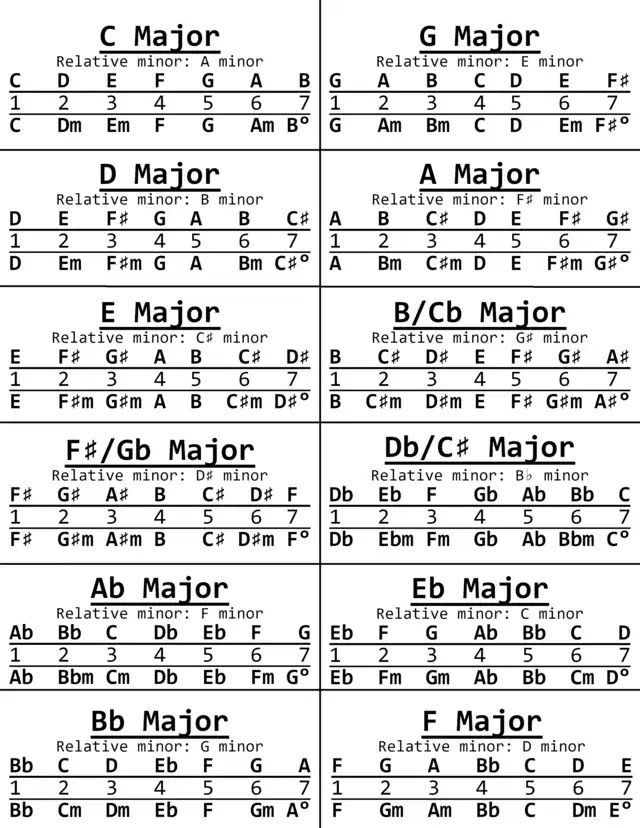Understanding music theory is like having a roadmap to the vast world of guitar playing. While many guitarists rely on feel and intuition, integrating music theory into your practice can elevate your playing, enhance your creativity, and deepen your understanding of music. In this post, we’ll explore the essentials of guitar music theory and how they can transform your musical journey

1. The Musical Alphabet
At its core, music theory begins with the musical alphabet: A, B, C, D, E, F, and G. These seven letters represent the natural notes. Each note can be sharpened (#) or flattened (b), resulting in 12 unique pitches: A, A#, B, C, C#, D, D#, E, F, F#, G, and G#. Understanding this foundation is crucial for learning scales, chords, and progressions.
2. The Fretboard Layout
The guitar fretboard is a visual and tactile representation of the musical alphabet. Each fret represents a half-step, or semitone, moving up the musical alphabet. Learning the notes on the fretboard helps you navigate scales, form chords, and transpose songs. Start by memorizing the notes on the low E and A strings, as these are often used as reference points for chords and scales.
3. Intervals
Intervals are the building blocks of music. An interval is the distance between two notes. The most common intervals include:
- Minor Second: 1 fret
- Major Second: 2 frets
- Minor Third: 3 frets
- Major Third: 4 frets
- Perfect Fourth: 5 frets
- Perfect Fifth: 7 frets
- Minor Sixth: 8 frets
- Major Sixth: 9 frets
- Minor Seventh: 10 frets
- Major Seventh: 11 frets
- Octave: 12 frets
Understanding intervals helps you build scales and chords and recognize melodic and harmonic patterns.
4. Scales
Scales are sequences of notes arranged in ascending or descending order. The most commonly used scales in guitar music are:
- Major Scale: W-W-H-W-W-W-H (where W = whole step, H = half step)
- Minor Scale: W-H-W-W-H-W-W
- Pentatonic Scale: A five-note scale often used in rock, blues, and pop music.
- Blues Scale: A variation of the pentatonic scale with an added “blue” note.
Practicing scales improves finger dexterity, helps with improvisation, and provides a framework for melody and soloing.
5. Chords
Chords are combinations of three or more notes played simultaneously. The most basic chords are:
- Major Chords: Root, major third, perfect fifth
- Minor Chords: Root, minor third, perfect fifth
- Seventh Chords: Major or minor chords with an added seventh note (e.g., C7, Cm7)
- Extended Chords: Chords with added tensions like ninths, elevenths, and thirteenths
Learning chord construction and how chords relate to each other (chord progressions) is essential for rhythm guitar playing and songwriting.
6. Chord Progressions
Chord progressions are sequences of chords that create harmony in a piece of music. Common progressions include:
- I-IV-V: Widely used in rock, pop, and blues (e.g., C-F-G)
- ii-V-I: Common in jazz (e.g., Dm-G7-C)
- vi-IV-I-V: Popular in pop music (e.g., Am-F-C-G)
Understanding progressions helps you anticipate chord changes, compose music, and accompany other musicians.
7. Modes
Modes are variations of scales that start on different scale degrees. The seven modes derived from the major scale are:
- Ionian (major scale)
- Dorian
- Phrygian
- Lydian
- Mixolydian
- Aeolian (natural minor scale)
- Locrian
Each mode has a unique sound and can be used to add variety to your playing and compositions.
8. Arpeggios
Arpeggios are broken chords where the notes are played sequentially rather than simultaneously. Practicing arpeggios helps with finger strength, precision, and understanding chord shapes across the fretboard.
9. Rhythm and Timing
Rhythm and timing are fundamental aspects of music theory. Understanding note values (whole, half, quarter, eighth, sixteenth notes) and time signatures (4/4, 3/4, 6/8) ensures you stay in sync with other musicians and maintain a steady tempo.
10. Harmonic Analysis
Harmonic analysis involves examining how chords and progressions function within a piece of music. This includes identifying the key, chord functions (tonic, dominant, subdominant), and modulations (key changes). Analyzing songs deepens your understanding of music structure and enhances your arrangement and composition skills.
Conclusion
Integrating guitar music theory into your practice routine unlocks a deeper understanding of your instrument and the music you play. It provides a solid foundation for improvisation, composition, and overall musicality. Whether you’re a beginner or an advanced player, exploring these concepts will enhance your playing and open up new creative possibilities. Happy learning, and keep strumming!
- 🎶 Flute Lesson for Beginners: Learn Your First Notes Easily
- Homesteading Knowledge: Back-to-Basics Skills for Self-Reliant Living
- 🎸 Dmaj7 Guitar Chord: A Smooth and Dreamy Sound for Your Songs
- July 5th in America: The Quiet Day After the Boom
- Who Is Vanessa Trump? Inside the Life of Donald Trump Jr.’s Former Wife